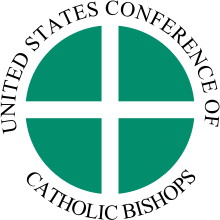Roman Catholic Archdiocese of New Orleans
The Roman Catholic Archdiocese of New Orleans, (Latin: Archidioecesis Novae Aureliae, French: Archidiocèse de la Nouvelle-Orléans, Spanish: Arquidiócesis de Nueva Orleans), is an ecclesiastical division of the Roman Catholic Church administered from New Orleans, Louisiana. It is the second-oldest diocese in the present-day United States, having been elevated to the rank of diocese on April 25, 1793, by Pope Pius VI during Spanish colonial rule. Our Lady of Prompt Succor and St. Louis, King of France are the patron saints of the archdiocese and Cathedral Basilica of Saint Louis is its mother church as St. Patrick's Church serves as the Pro-Cathedral of the archdiocese.
Archdiocese of New Orleans Archidioecesis Novae Aureliae Archidiocèse de La Nouvelle-Orléans Arquidiócesis de Nueva Orleans | |
|---|---|
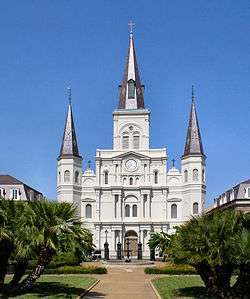 Cathedral Basilica of St. Louis | |
 | |
| Location | |
| Country | |
| Territory | Parishes of Jefferson (except Grand Isle), Orleans, Plaquemines, St. Bernard, St. Charles, St. John the Baptist, St. Tammany, Washington |
| Ecclesiastical province | Archdiocese of New Orleans |
| Statistics | |
| Area | 4,208 sq mi (10,900 km2) |
| Population - Total - Catholics | (as of 2013) 1,238,228 520,056 (42%) |
| Parishes | 107 |
| Churches | ~137 |
| Schools | +25 |
| Information | |
| Denomination | Catholic |
| Sui iuris church | Latin Church |
| Rite | Roman Rite |
| Established | April 25, 1793 (227 years) |
| Cathedral | Cathedral Basilica of Saint Louis |
| Patron saint | St. Louis Our Lady of Prompt Succor |
| Secular priests | 387 |
| Current leadership | |
| Pope | Francis |
| Archbishop | Gregory Michael Aymond |
| Auxiliary Bishops | Fernand J. Cheri |
| Bishops emeritus | Alfred Clifton Hughes |
| Map | |
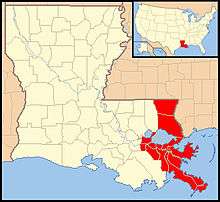 | |
| Website | |
| arch-no.org | |
Led by an archbishop, the Archdiocese of New Orleans is the center of a larger ecclesiastical province that encompasses the entire state of Louisiana. The Metropolitan Province of New Orleans include the suffragan Dioceses of Alexandria, Baton Rouge, Houma-Thibodaux, Lafayette, Lake Charles, and Shreveport.
On June 12, 2009, Pope Benedict XVI named Bishop Gregory Michael Aymond of the Diocese of Austin to be Archbishop of New Orleans. Archbishop Aymond was installed on August 20, 2009 at Saint Louis Cathedral.
Summary
The archdiocese encompasses eight civil parishes in the New Orleans metropolitan area: Jefferson (except Grand Isle)[note 1] Orleans, Plaquemines, St. Bernard, St. Charles, St. John the Baptist, St. Tammany, and Washington. There are 137 church parishes in the archdiocese, ministered by 387 priests (including those belonging to religious institutes), 187 permanent deacons, 84 brothers, and 432 sisters. There are 372,037 Catholics on the census of the archdiocese, 36% of the total population of the area. The current head of the archdiocese is Archbishop Gregory Michael Aymond. There is one Archbishop Emeritus: Archbishop Alfred Clifton Hughes. There is also one Auxiliary Bishop Emeritus: Bishop Dominic Carmon, S.V.D.
History

The Catholic Church has had a presence in New Orleans since before the founding of the city by the French in 1718. Missionaries served the French military outposts and worked among the native peoples. The area was then under the jurisdiction of the Bishop of Quebec. In 1721 Fr. Francis-Xavier de Charlevoix, S.J., made a tour of New France from the Lakes to the Mississippi, and visiting New Orleans, he describes "a little village of about one hundred cabins dotted here and there, a large wooden warehouse in which I said Mass, a chapel in course of construction and two storehouses".[2]
In 1722 the Capuchins were assigned ecclesiastical responsibility for the Lower Mississippi Valley, while the Jesuits maintained a mission, based in New Orleans, to serve the indigenous peoples. The Jesuit vicar-general returned to France to recruit priests and also persuaded the Ursulines of Rouen to assume charge of a hospital and school. The royal patent authorizing the Ursulines to found a convent in Louisiana was issued September 18, 1726. Ten religious from various cities sailed from Hennebont on January 12, 1727, and reached New Orleans on August 6. As the convent was not ready, the governor gave up his residence to them. They opened a hospital for the care of the sick and a school for poor children.[2]
New Orleans and the rest of Louisiana west of the Mississippi were surrendered to the Spanish in 1763. From then until 1783 the East and West Florida were under British control, but as part of the Peace of Paris (1783) the two Florida colonies were regained from Great Britain. Thus, the pioneer parishes of New Orleans and Louisiana were incorporated into the Diocese of Louisiana and the Two Floridas when it was erected on April 25, 1793. The diocese originally encompassed the entire Louisiana Purchase, from the Gulf of Mexico to British North America, as well as the Florida peninsula and the Gulf Coast.[2]
The date of its establishment makes it the second-oldest diocese in the present-day United States: the Diocese of Baltimore was established on November 6, 1789. At the time of its establishment, the territory of the Diocese of Louisiana and the Two Floridas was part of the Archdiocese of San Cristobal de la Habana, based in Havana, Cuba.
The diocese was divided into smaller dioceses several times, and many modern dioceses in the central United States were originally part of the Diocese of Louisiana. As capital of the Louisiana, the city was sold to the United States in 1803. The diocese was renamed the Diocese of New Orleans in 1826, and encompassed what is now Louisiana and Mississippi. New Orleans was elevated to an archdiocese in 1850. As the population of Louisiana grew, the Archdiocese of New Orleans was further subdivided into several additional dioceses.
In its long history, the archdiocese and the city of New Orleans have survived several major disasters, including several citywide fires, a British invasion, the American Civil War, multiple yellow fever epidemics, anti-immigration and anti-Catholicism, the New Orleans Hurricane of 1915, Segregation, Hurricane Betsy, and an occasional financial crisis, not to mention Hurricane Katrina. Each time, the archdiocese rebuilt damaged churches and rendered assistance to the victims of every disaster. More recently, the church has faced an increased demand for churches in the suburbs and a decline in attendance to inner-city parishes. The church has also weathered changes within the Roman Catholic Church, such as the Second Vatican Council, and changing spiritual values throughout the rest of the United States.[3]
The archdiocese sustained severe damage from Hurricane Katrina and Hurricane Rita. Numerous churches and schools were flooded and battered by hurricane-force winds. In the more heavily flooded neighborhoods, such as St. Bernard Parish, many parish structures were wiped out entirely.[4]
Politics
In early 2009, the state of Maine passed a law allowing same-sex civil marriage. In July 2009 the Roman Catholic Archdiocese of New Orleans contributed $2,000 of its money to a referendum campaign to overturn that law.[5] According to Maine's "Commission on Governmental Ethics & Election Practices", the Roman Catholic Diocese of Portland Maine spent over $553,000 to overturn the law. The Archdiocese of New Orleans' $2,000 was part of that $553,000.[6]
Sex abuse
As of 2019, the Archdiocese of New Orleans has listed 81 clergy who were "credibly accused" of committing acts of sex abuse while they were serving in the archdiocese. Some settled lawsuits filed against them while one, Francis LeBlanc, was convicted in 1996.[7] Archbishop Alfred Hughes acknowledged that for sex abuse claims during 1950–2003, the archdiocese and its insurers paid $1,187,066 for settlements, $448,735 for therapy, and $421,372 for legal fees. Additional settlements were reached by 2019 as well.[8]
On January 24, 2020, staff of the New Orleans Saints admitted that the football team's Senior Vice President for Communications Greg Bensel "offered input on how to work with the media" to help the Archdiocese of New Orleans handle the sex abuse scandal.[9] Bensel advised the Archdiocese to "Be direct, open and fully transparent, while making sure that all law enforcement agencies were alerted."[9][10] Bensel was among a number of community and civic leaders consulted by the Archdiocese before releasing the accused clergy names in November 2018.[9][10]
On May 8, 2020, it was revealed that the leader of the board of directors for one of the Archdiocese of New Orleans' various ministries resigned his post recently after claiming in a lawsuit against the church that he was molested by one of its priests decades ago.[11] The plaintiff who spoke on anonymity, claimed he resigned under duress.[11] The Archdiocese, which mediated a settlement in 2019, had previously agreed to pay for expenses which the plaintiff paid for six years of counseling.[11] However, the plaintiff filed his lawsuit on April 7, 2020, after claiming that he discovered that the priest who allegedly molested him, James Collery, had more victims.[11] Collery died in 1987.[11] The lawsuit also claimed that the plaintiff first reported the abuse in 2013.[11]
On May 19, 2020, it was revealed that all surviving accused clergy who served in the Archdiocese of New Orleans had their payments suspended as part of the bankruptcy settlement, though some were trying to get their payments reinstated.[12] Among those who tried to restore payment was retired Archdiocese of New Orleans priest Paul Calamari, who tried to get his pension reinstated by admitting to U.S. Bankruptcy Judge Meredith Grabill on May 18, 2020 that he had a “failing” and a “sin” with a 17 year old high school boy in 1973.[12]
Bankruptcy
On May 1, 2020, it was announced that the Archdiocese of New Orleans had filed for Chapter 11 Bankruptcy. The causes of the decision were said to be the mounting cost of litigation from sexual abuse cases and the unforeseen financial consequences of the COVID-19 pandemic.[13] The Archdiocese, which had a $45 million budget,[14] owed $38 million in bonds to creditors and was also facing more pending sex abuse lawsuits.[14][15] The pending sex abuse lawsuits, which were suspended due to the bankruptcy filing,[15] would likely result in the already financially struggling Archdiocese of New Orleans losing millions of dollars more.[14]
Heritage
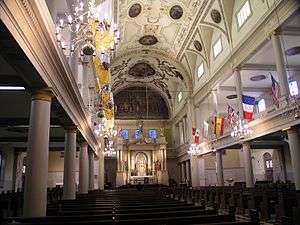
The Archdiocese of New Orleans is a culturally diverse community within the diverse city of New Orleans. As a major port, the city has attracted immigrants from around the world. Since French and Spanish Catholics ruled the city, they encouraged enslaved Africans to adopt Christianity. The city has a large population of African American Catholics with deep heritage in the area. Later European immigrants, such as the Irish, Italians, Polish, and German Bavarians have also been a part of the archdiocese throughout its history. In the last quarter of the 20th century, many Vietnamese Catholics from South Vietnam settled in the city. New waves of immigrants from Mexico, Honduras, Nicaragua and Cuba have added to the Catholic congregations.
Landmarks
The best known church in the New Orleans Archdiocese is the historic St. Louis Cathedral fronting the Spanish Plaza de Armas, now Jackson Square, in the French Quarter. This church was originally built in 1718, shortly after the founding of the city. The modest building was destroyed by fire several times before the current structure was built between 1789 and 1794 during the Spanish domination. During renovations to the cathedral between 1849 and 1851, St. Patrick's Church, the second-oldest parish in the city, served as the pro-cathedral of the archdiocese.
Bishops
The Diocese of Louisiana and the Two Floridas was erected on April 25, 1793; it encompassed the area claimed by Spain as Luisiana, which was all the land draining into the Mississippi River from the west, as well as Spanish territory to the east of the river in modern-day Mississippi, Alabama, and Florida.
In April 1803, the United States purchased Louisiana from France, which had in 1800 forced Spain to retrocede the territory in the Third Treaty of San Ildefonso. The United States took formal possession of New Orleans on December 20, 1803, and of Upper Louisiana on March 10, 1804. The then-Bishop John Carroll of Baltimore served as apostolic administrator of the diocese from 1805 to 1812; during this period, the diocese became a suffragan of Baltimore. Archbishop Carroll's successor as apostolic administrator would eventually be the diocese's first resident bishop of the 19th century.
In 1823, Joseph Rosati was appointed coadjutor bishop of the diocese. In 1825, the territory of the diocese in what is now Alabama and Florida was transferred to the new Vicariate Apostolic of Alabama and the Floridas, and in 1826, the diocese was renamed, becoming the Diocese of New Orleans. At the same time, the diocese's territory was further reduced by the creation of the Vicariate Apostolic of Mississippi and the Diocese of St. Louis. Bishop Rosati served as the diocese's apostolic administrator from 1826 to 1829; having been appointed bishop of St. Louis two years previously, he resigned the administration of the New Orleans diocese upon the appointment of Bishop de Neckere.
Bishops of Louisiana and the Two Floridas
- Luis Ignatius Peñalver y Cárdenas (1795-1801), then appointed Archbishop of Guatemala
- Francisco Porró y Reinado (disputed,[16] 1801-1803), then appointed Bishop of Tarazona in Spain
- Louis-Guillaume Dubourg (1815-1825), then appointed Bishop of Montauban and later Archbishop of Besançon in France
- Leo-Raymond de Neckere (1830-1833), until his death
(Auguste Jeanjean was appointed, 1834; did not take effect.)
Archbishops of New Orleans
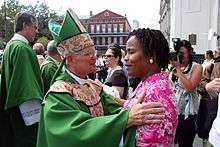
- Antoine Blanc (1835-1860); raised from Bishop to Archbishop in 1850 when New Orleans became archdiocese
- Jean-Marie Odin (1861-1870)
- Napoléon-Joseph Perché (1870-1883)
- Francis Xavier Leray (1883-1887)
- Francis Janssens (1888-1897)
- Placide-Louis Chapelle (1897-1905)
- James Blenk, S.M. (1906-1917)
- John W. Shaw (1918-1934)
- Joseph F. Rummel (1935-1964)
- John P. Cody (1964-1965), appointed Archbishop of Chicago (elevated to Cardinal in 1967)
- Philip M. Hannan (1965-1989)
- Francis B. Schulte (1989-2002)
- Alfred C. Hughes (2002-2009)
- Gregory M. Aymond (2009–present)
Auxiliary bishops
- Gustave Augustin Rouxel (1899-1908)
- John Laval (1911-1937)
- Louis Abel Caillouet (1947-1976)
- Harold R. Perry (1966-1991)
- Stanley Joseph Ott (1976-1983), appointed Bishop of Baton Rouge
- Robert William Muench (1990-1996), appointed Bishop of Covington and later Bishop of Baton Rouge
- Dominic Carmon (1993–2006)
- Gregory Michael Aymond (1997-2000), appointed Coadjutor Bishop and later Bishop of Austin and Archbishop of New Orleans
- Roger Paul Morin (2003-2009), appointed Bishop of Biloxi
- Shelton Joseph Fabre (2007-2013), appointed Bishop of Houma-Thibodaux
- Fernand J. Cheri (2015–present)
Other priests of this diocese who became bishops
- Thomas Heslin, appointed Bishop of Natchez in 1889
- Cornelius Van de Ven, appointed Bishop of Natchitoches in 1904
- Jules Jeanmard, appointed Bishop of Lafayette in Louisiana in 1918
- Robert Emmet Tracy, appointed Auxiliary Bishop of Lafayette in Louisiana in 1959 and later Bishop of Baton Rouge
- Joseph Gregory Vath, appointed Auxiliary Bishop of Mobile-Birmingham in 1966
- Gerard Louis Frey, appointed Bishop of Savannah in 1967 and later Bishop of Lafayette in Louisiana
- William Donald Borders (priest here 1940-1961), appointed Bishop of Orlando in 1968 and later Archbishop of Baltimore
- John Clement Favalora, appointed Bishop of Alexandria in 1986 and later Bishop of Saint Petersburg and Archbishop of Miami
- Thomas John Rodi, appointed Bishop of Biloxi in 2001 and later Archbishop of Mobile
- Joseph Nunzio Latino (priest here 1963-1977), appointed Bishop of Jackson in 2003
- Dominic Mai Luong, appointed Auxiliary Bishop of Orange in 2003
Parishes
The 108 parishes of the archdiocese are divided into 10 deaneries.
Schools
There are 5 Roman Catholic colleges and over 20 high schools within the Archdiocese of New Orleans. Many of the churches throughout the archdiocese have primary schools as well.
Previously Catholic schools were racially segregated. In 1962 there were 153 Catholic schools; that year the archdiocese began admitting black students into schools that did not admit them; that year about 200 black children attended the archdiocese's Catholic schools previously not reserved for black children. The desegregation occurred two years after public schools had integrated. Bruce Nolan of The Times Picayune stated that because Catholic schools had a later desegregation, white liberal and African-American groups faced disappointment but that the integration had not produced as intense of a backlash.[17]
Seminaries
Ecclesiastical province of New Orleans
- See: List of the Catholic bishops of the United States#Province of New Orleans
See also
- List of the Roman Catholic dioceses of the United States#Ecclesiastical province of New Orleans
- Category:Roman Catholic Archdiocese of New Orleans
Notes
- Unlike the rest of Jefferson Parish, the church of Grand Isle is not in the New Orleans archdiocese, but instead in the Roman Catholic Diocese of Houma-Thibodaux.[1]
References
- "Home". Our Lady of the Isle. Retrieved May 28, 2020.
- Points, Marie Louise. "New Orleans." The Catholic Encyclopedia Vol. 11. New York: Robert Appleton Company, 1911. November 19, 2017
- Nolan, Charles E. "A Brief History of the Archdiocese of New Orleans." 2001 May.
- Finney, Peter. "Devastation." The Clarion Herald. 2005 Oct. 1. Vol. 44, No. 9.
- Chuck Colbert (November 25, 2009). "Dioceses major contributors to repeal same-sex marriage". National Catholic Reporter. Kansas City, Missouri. Retrieved November 29, 2009.
- https://bishop-accountability.org/member/psearch.jsp (password required)
- http://www.bishop-accountability.org/usccb/natureandscope/dioceses/neworleansla.htm
- https://www.neworleanssaints.com/news/statement-from-the-new-orleans-saints
- https://wgntv.com/2020/01/25/new-orleans-saints-confirm-staff-helped-archdiocese-during-sex-abuse-revelations-tmw/
- https://www.nola.com/news/courts/article_81b6ff5a-9168-11ea-807f-7feb604a2f05.html
- https://www.nola.com/news/courts/article_811d6844-9a06-11ea-9928-d39566306fcf.html
- "Archdiocese of New Orleans files for bankruptcy". The Catholic World Report. May 1, 2020. Retrieved May 1, 2020.
- https://www.nola.com/news/article_218195d2-8b32-11ea-91a1-9f3a0d4bb562.html
- https://www.fox8live.com/2020/05/01/attorneys-alleged-victims-church-sex-abuse-respond-archdiocese-new-orleans-bankruptcy-filing/
- "Bishops of Archdiocese". St. Louis Cathedral. Retrieved December 3, 2019.
Penalver, First Bishop... DuBourg, Second Bishop, after an interval marked by rebellion against ecclesiastical authority... de Neckere, Third Bishop
- Nolan, Bruce (November 15, 2010). "New Orleans area Catholic schools integrated 2 years after the city's public schools". The Times Picayune. Retrieved May 30, 2020.
![]()
External links
| Wikimedia Commons has media related to Roman Catholic Archdiocese of New Orleans. |
- Roman Catholic Archdiocese of New Orleans Official Site
- Roman Catholic Archdiocese of New Orleans (archdiocese-no.org) at the Wayback Machine (archive index)
- Nolan, Charles E. A History of the Archdiocese of New Orleans May 2001
- Archdiocesan Statistics.
- Catholic Charities of New Orleans.
- The Clarion Herald, the official newspaper of the Archdiocese of New Orleans.
- John and Kathleen DeMajo. Gallery of New Orleans Churches, including numerous Catholic Churches.
